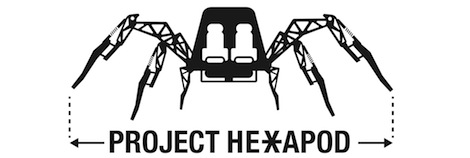It may not be as cool as a bear riding a jet ski on a shark in outer space, but Stompy, the giant, rideable walking hexapod comes very close.
A few months ago, we caught wind of a gigantic rideable hexapod project brewing at the Artisan’s Asylum hackerspace in Somerville, MA. The goal was to build an 18-foot wide, two ton rideable hexapod robot, with the side benefit of teaching students how to weld, code, and other subjects related to giant machines and mechatronics.
The Stompy team has now launched a Kickstarter asking for donations to pay for the materials, plasma cutting, and other bits of hardware required to make Stompy a reality. Since there isn’t much information on amateur level hydraulics, the project is open source; the trials of building Stompy will be made public freely available for any other giant robot project.
Team Stompy has successfully built, debugged, and tested a half-size prototype of one hydraulically powered leg that is able to ‘row’ across the floor under its own power. This is a huge achievement for the team and now they’ll move on to the full-size single leg prototype.
You can see the team’s single leg prototype in action after the break.
[youtube=http://www.youtube.com/watch?v=sFVmMEJi8UI&w=470]
[youtube=http://www.youtube.com/watch?v=raRQu9Un3_I&w=470]
















Why is the movement so…not smooth? Are you using pneumatic cylinders without any damping?
http://www.youtube.com/watch?v=Q1CMSV81_ws
I see your CAT climbing some platforms and raise you a Liebherr climbing up multiple floors of a tower:
http://www.youtube.com/watch?v=VBMUvAUPTGM&t=2m56s
That is one of the coolest videos I’ve seen in quite a while.
Whoever is driving has a lot of confidence.
I’m on the team and can answer a few questions :)
The upper video is smoother than the bottom. The bottom video was when we first tried “rowing” for the first time.
A lot of the jerky-ness in motion we believe is caused by the scale and quality of our pistons to the movement. For the half scale leg we used small cheap cylinders. The fact that the cylinders were small means that there isn’t much fluid volume in each cylinder (a few cubic inches). This means that for our standard movement speeds the valves were operating at their extreme lower limits.
We expect to see great improvement when we switch to the full scale leg prototype which uses higher quality cylinders and greater fluid volume (50+ cubic inches).
hmm what should i buy a Kuratas or a Stompy
http://www.youtube.com/watch?feature=player_detailpage&v=2iZ0WuNvHr8
Sure with Kuratas you can kill all humans.
But with Stompy, you can CRUSH them.
Ha, it says its “gasoline fueled and runs on a diesel engine” that is interesting…
It could be a multi-fuel diesel engine like in tanks, they run on almost anything ;)
I’ve seen the engine. It’s a diesel motor converted to run on propane, so that they can run it indoors. A diesel->propane conversion is a relatively easy/common thing to do.
Now this is rowing http://www.youtube.com/watch?v=7odAbL3Ygts
As an chassis engineer I can easily say that the guy who designed the legs and the guy who designed the vehicle frame were probably not the same guy.